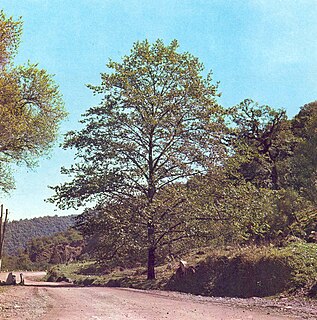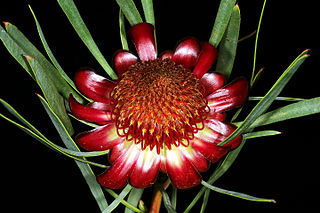
A banana is an elongated, edible fruit – botanically a berry – produced by several kinds of large herbaceous flowering plants in the genus Musa. In some countries, bananas used for cooking may be called "plantains", distinguishing them from dessert bananas. The fruit is variable in size, color, and firmness, but is usually elongated and curved, with soft flesh rich in starch covered with a rind, which may be green, yellow, red, purple, or brown when ripe. The fruits grow upward in clusters near the top of the plant. Almost all modern edible seedless (parthenocarp) bananas come from two wild species – Musa acuminata and Musa balbisiana. The scientific names of most cultivated bananas are Musa acuminata, Musa balbisiana, and Musa × paradisiaca for the hybrid Musa acuminata × M. balbisiana, depending on their genomic constitution. The old scientific name for this hybrid, Musa sapientum, is no longer used.

Magnolia is a large genus of about 210 flowering plant species in the subfamily Magnolioideae of the family Magnoliaceae. It is named after French botanist Pierre Magnol.

Magnolia acuminata, commonly called the cucumber tree, cucumber magnolia or blue magnolia, is one of the largest magnolias, and one of the cold-hardiest. It is a large forest tree of the Eastern United States and Southern Ontario in Canada. It is a tree that tends to occur singly as scattered specimens, rather than in groves.

Aporosa is a genus of flowering plant belonging to the family Phyllanthaceae, first described as a genus in 1825. It is native to China, the Indian Subcontinent, Southeast Asia, Papuasia, and Queensland.

Bridelia is a plant genus of the family Phyllanthaceae first described as a genus in 1806. It is widespread across Africa, Australia, southern Asia, and various islands of the Indian and Pacific Oceans.

Musa is one of two or three genera in the family Musaceae. The genus includes flowering plants producing edible bananas and plantains. Around 70 species of Musa are known, with a broad variety of uses.

Bauhinia acuminata is a species of flowering shrub native to tropical southeastern Asia. Common names include dwarf white bauhinia, white orchid-tree and snowy orchid-tree. The exact native range is obscure due to extensive cultivation, but probably from Malaysia, Indonesia, and the Philippines.
Banksia acuminata is a rare prostrate shrub endemic to south-west Western Australia. It was published in 1848 as Dryandra preissii, but transferred into Banksia as B. acuminata in 2007.

Grevillea mucronulata, also known as green spider flower or green grevillea, is a shrub of the family Proteaceae that is endemic to New South Wales in Australia. Described by Robert Brown in 1810, it is found in open sclerophyll forest or woodland around the Sydney region and New South Wales south coast. It grows as a small bush to 3 metres high and wide, with variable foliage and greenish flowers that appear over the cooler months from May to October. The flowers are attractive to birds.

Alnus acuminata is a species of deciduous tree in the Betulaceae family. It is found in montane forests from central Mexico to Argentina.

Aporosa bourdillonii is a species of plant in the family Phyllanthaceae. It is endemic to India. It prefers evergreen and semi-evergreen forests.

Crepis acuminata is a North American species of flowering plant in the daisy family known by the common name tapertip hawksbeard. It is native to the western United States where it grows in many types of open habitat.

Musa acuminata is a species of banana native to Southern Asia, its range comprising the Indian Subcontinent and Southeast Asia. Many of the modern edible dessert bananas are from this species, although some are hybrids with Musa balbisiana. First cultivated by humans around 10 kya, it is one of the early examples of domesticated plants.

Persoonia brevifolia is a plant in the family Proteaceae and is endemic to a restricted area near the border between south-eastern New South Wales and Victoria. It is an erect shrub with elliptic to egg-shaped leaves and cylindrical yellow flowers arranged singly in leaf axils.

Persoonia acuminata is a plant in the family Proteaceae and is endemic to New South Wales. It is a spreading or prostrate shrub with relatively small leaves and cylindrical yellow flowers arranged singly or in groups of up to sixteen in leaf axils or on the ends of the branches. It grows in moist forest on the higher parts of the tablelands.

Protea acuminata, also known in English as the black-rim sugarbush, or in the Afrikaans language as sederbergsuikerbos, is a flowering shrub belonging to the genus Protea. The plant is endemic to South Africa. There are isolated populations at Nieuwoudtville, and in the Cederberg, Stettynskloof and Riviersonderend Mountains. It can grow as an upright tree. It can become up to two metres in height. It blooms from June to September, with the peak of July to August. Periodic wildfires may destroy the adult plants, but the seeds can survive such an event. The seeds are dispersed by means of the wind. The plant is monoecious with both sexes in each flower. It is unknown what causes the pollination to occur. The plant grows in sandy plains and coastal lowlands from sea-level to altitudes of 400 metres. It is a widespread species which is not in danger, and the conservation status has been assessed as 'least concern'.

Lonicera acuminata, commonly known as fragrant grove honeysuckle or vine honeysuckle, is a plant species of honeysuckle native to China to Southeast Asia and India.

Aporosa octandra is a species of plant in the family Phyllanthaceae found from Queensland and New Guinea to Indonesia, Zhōngguó/China and India. It is a highly variable plant with 4 named varieties. Its wood is used in construction and to make implements, its fruit is edible. The Karbi people of Assam use the plant for dyeing, textile colours have quite some significance in their culture.
Aporosa tetrapleura is a species of plant in the family Phyllanthaceae found in Cambodia and Vietnam. The wood is used in house and cattle barn construction and as firewood.
Aporosa villosa is a species of shrub or small tree in the family Phyllanthaceae. It is found in Southeast Asia, including the Nicobar, Andaman and Paracel Islands. There are some traditional medicinal uses for plant, particularly around care after childbirth. The shrub is often a pioneer species, tolerant of full sun, but intolerant of frequent fires.
















